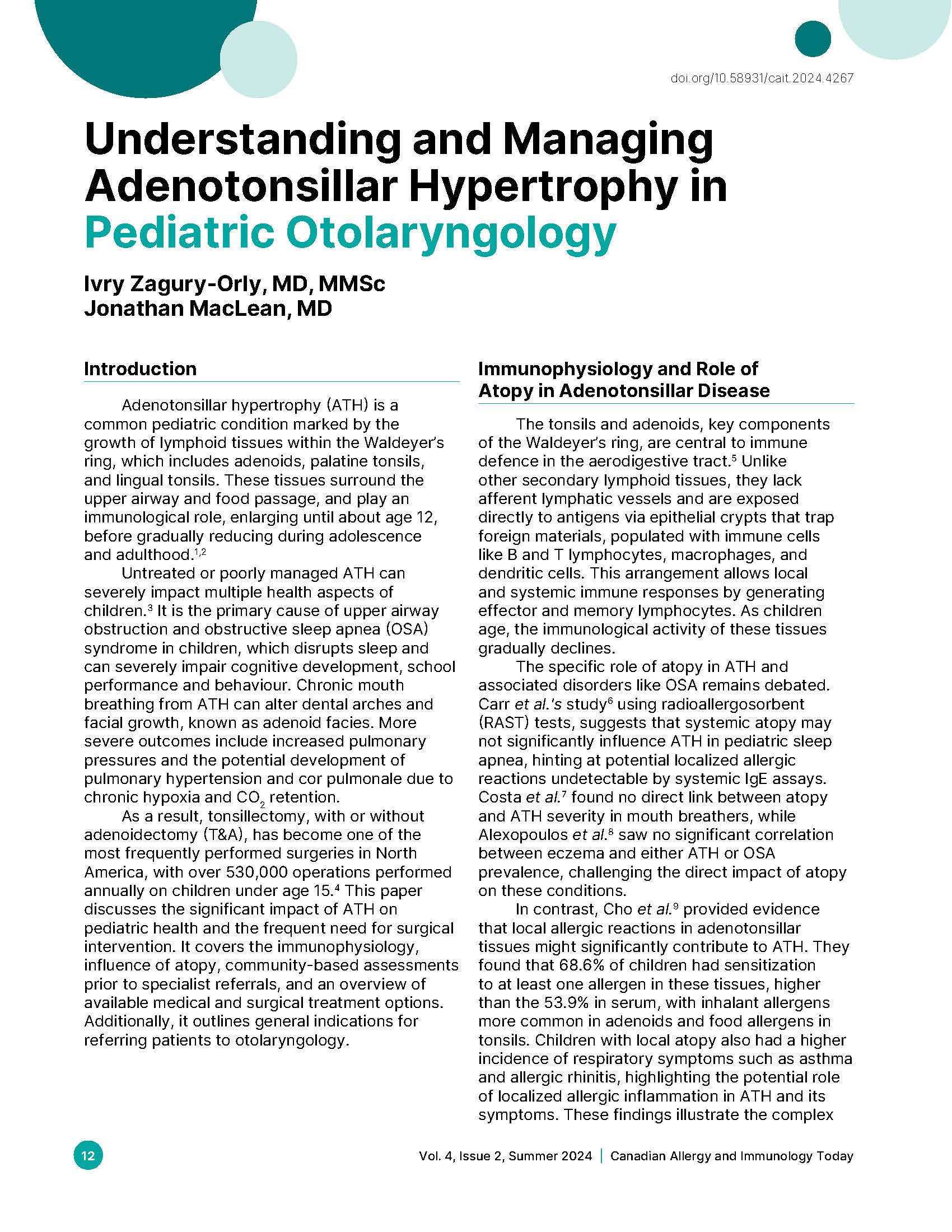Understanding and Managing Adenotonsillar Hypertrophy in Pediatric Otolaryngology
DOI:
https://doi.org/10.58931/cait.2024.4267Abstract
Adenotonsillar hypertrophy (ATH) is a common pediatric condition marked by the growth of lymphoid tissues within the Waldeyer’s ring, which includes adenoids, palatine tonsils, and lingual tonsils. These tissues surround the upper airway and food passage, and play an immunological role, enlarging until about age 12, before gradually reducing during adolescence and adulthood.
Untreated or poorly managed ATH can severely impact multiple health aspects of children. It is the primary cause of upper airway obstruction and obstructive sleep apnea (OSA) syndrome in children, which disrupts sleep and can severely impair cognitive development, school performance and behaviour. Chronic mouth breathing from ATH can alter dental arches and facial growth, known as adenoid facies. More severe outcomes include increased pulmonary pressures and the potential development of pulmonary hypertension and cor pulmonale due to chronic hypoxia and CO2 retention.
As a result, tonsillectomy, with or without adenoidectomy (T&A), has become one of the most frequently performed surgeries in North America, with over 530,000 operations performed annually on children under age 15. This paper discusses the significant impact of ATH on pediatric health and the frequent need for surgical intervention. It covers the immunophysiology, influence of atopy, community-based assessments prior to specialist referrals, and an overview of available medical and surgical treatment options. Additionally, it outlines general indications for referring patients to otolaryngology.
References
Niedzielski A, Chmielik LP, Mielnik-Niedzielska G, et al. Adenoid hypertrophy in children: a narrative review of pathogenesis and clinical relevance. BMJ Paediatr Open. 2023;7(1):e001710.
Winkelmann A. Wilhelm von Waldeyer-Hartz (1836-1921): An anatomist who left his mark. Clin Anat N Y N. 2007;20(3):231-4.
Nelson R. Adenotonsillar disease has a detrimental effect on children’s quality of life. The Lancet. 2002;360(9338):1002.
Hall MJ, Schwartzman A, Zhang J, et al. Ambulatory surgery data from hospitals and ambulatory surgery centers: United States, 2010. Natl Health Stat Rep. 2017;(102):1-15.
van Kempen MJ, Rijkers GT, Van Cauwenberge PB. The immune response in adenoids and tonsils. Int Arch Allergy Immunol. 2000;122(1):8-19.
Carr E, Obholzer R, Caulfield H. A prospective study to determine the incidence of atopy in children undergoing adenotonsillectomy for obstructive sleep apnea. Int J Pediatr Otorhinolaryngol. 2007;71(1):19-22.
Costa EC, Sabino HAC, Miura CS, et al. Atopy and adenotonsillar hypertrophy in mouth breathers from a reference center. Braz J Otorhinolaryngol. 2013;79(6):663-7.
Alexopoulos EI, Bizakis J, Gourgoulianis K, et al. Atopy does not affect the frequency of adenotonsillar hypertrophy and sleep apnoea in children who snore. Acta Paediatr. 2014;103(12):1239-43.
Cho KS, Kim SH, Hong SL, et al. Local atopy in childhood adenotonsillar hypertrophy. Am J Rhinol Allergy. 2018;32(3):160-6.
Kheirandish-Gozal L, Bandla HPR, Gozal D. Montelukast for children with obstructive sleep apnea: results of a double-blind, randomized, placebo-controlled trial. Ann Am Thorac Soc. 2016;13(10):1736-41.
Kheirandish-Gozal L, Gozal D. Intranasal budesonide treatment for children with mild obstructive sleep apnea syndrome. Pediatrics. 2008;122(1):e149-55.
Al-Ghamdi SA, Manoukian JJ, Morielli A, et al. Do systemic corticosteroids effectively treat obstructive sleep apnea secondary to adenotonsillar hypertrophy? The Laryngoscope. 1997;107(10):1382-7.
Marcus CL, Brooks LJ, Draper KA, et al. Diagnosis and management of childhood obstructive sleep apnea syndrome. Pediatrics. 2012;130(3):e714-55.
Mitchell RB, Kelly J. Quality of life after adenotonsillectomy for SDB in children. Otolaryngol Head Neck Surg. 2005;133(4):569-72.
Zhang L, Mendoza‐Sassi RA, César JA, et al. Intranasal corticosteroids for nasal airway obstruction in children with moderate to severe adenoidal hypertrophy. Cochrane Database Syst Rev. 2008;2008(3):CD006286.
Mitchell RB, Archer SM, Ishman SL, et al. Clinical Practice Guideline: Tonsillectomy in Children (Update). Otolaryngol Head Neck Surg. 2019;160(1_suppl):S1-S42.
Guilleminault C, Khramsov A, Stoohs RA, et al. Abnormal blood pressure in prepubertal children with sleep-disordered breathing. Pediatr Res. 2004;55(1):76-84.
Paradise JL, Bluestone CD, Bachman RZ, et al. Efficacy of tonsillectomy for recurrent throat infection in severely affected children. Results of parallel randomized and nonrandomized clinical trials. N Engl J Med. 1984;310(11):674-83.
Schraff S, McGinn JD, Derkay CS. Peritonsillar abscess in children: a 10-year review of diagnosis and management. Int J Pediatr Otorhinolaryngol. 2001;57(3):213-8.
Brietzke SE, Shin JJ, Choi S, et al. Clinical consensus statement: pediatric chronic rhinosinusitis. Otolaryngol Head Neck Surg. 2014;151(4):542-53.

